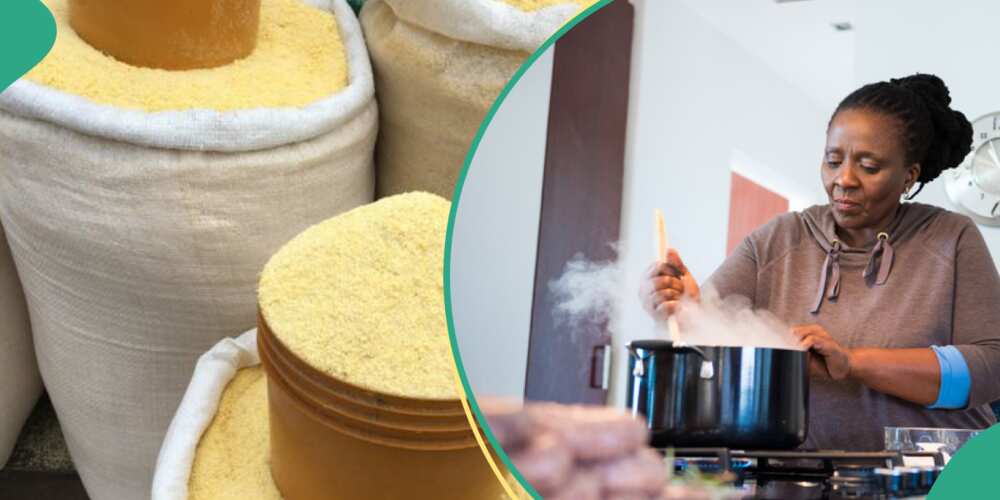No More N18,000/bag: Cost of Garri Spikes, Increases More Than 100 Percent
- The price of garri has increased significantly by over 100% in just a few months
- Across markets in Lagos, an investigation showed that a bag is now sold for N35,000 from N17,000 sold in December 2023
- Stakeholders cite issues like severe lack of dollars and the rising cost of inputs and others as reasons for the increase
PAY ATTENTION: The 2024 Business Leaders Awards Present Entrepreneurs that Change Nigeria for the Better. Check out their Stories!
Legit.ng journalist Zainab Iwayemi has over three years of experience covering the Economy, Technology, and Capital Market.
As cassava output declines, the price of garri, a popular staple food in Nigeria, has risen by 108% in just three months, reaching an all-time high.

Source: Getty Images
According to a BusinessDay survey conducted in many major markets, the average cost of a 50-kilogram bag of yellow Garri increased by 108% between December 2023 and March 2024, from N18,000 to N37,500.
Similarly, a 50kg bag of white Garri sells for N35,000, up from N17,000 sold in December 2023, while a 4-litre paint container measure of yellow Garri currently sells for an average of N2,500, up from N1,200 sold in December 2023. This is a 105% price increase.
Why price of garri is increasing
The Food and Agricultural Organization (FAO) estimates that Nigeria will produce and eat 60.8 million metric tons of cassava in 2022, making it the world's largest producer and consumer of the crop.
Farmers claim that the effects of climate change, increasing levels of insecurity, and the unpredictability surrounding last year's elections have hindered the production of tubers in 2023.
Nike Tinubu, CEO of Eagleson Cassava said:
“The harmattan season, known for its extreme dryness, has severely impacted cassava cultivation across the country, cutting production.

Read also
Nigeria Customs again increases dollar exchange rate to clear goods at ports as naira crashes
“The dryness has hardened the ground, making harvesting extremely difficult and more labour-intensive. This not only increases labour costs but also leads to post-harvest losses as some cassava roots break during the strenuous extraction process.”
She pointed out that this causes a shortage in produce and a significant spike in tuber prices.
The Nigeria Cassava Growers Association's (NCGA) national president, Segun Adewumi, stated that the uncertainty surrounding the 2023 elections deterred many farmers from growing the tubers last year.
Adewumi said:
“The uncertainty and potential disruption during the change in government discouraged farmers from cultivating cassava as extensively as usual. This is what led to the production shortfall.”
He added that in light of the severe lack of dollars and the rising cost of inputs, flour millers are increasingly blending more significant amounts of premium cassava flour with wheat, according to specialists.
“Millers are using more cassava flou,r and some industries have sprung up, using cassava, this has further increased the demand for the tubers.”
The yield of tubers has also decreased due to the growing rate of instability, as farmers have fled their farms in search of safety.
Experts estimate that due to increased insecurity, Nigeria has lost almost 60% of its food production in its major producing states. Due to the circumstances, most of the nation's crops are now producing less than they used to.
African Farmer Mogaji, chief executive officer of X-Ray Consulting, said:
“There are lots of farmlands that have been abandoned by farmers owing to the escalating insecurity in the country.”
Additionally, because of some of the difficulties in producing cassava, farmers are not increasing the size of their production fields; instead, some are switching to cultivating other crops, according to Mogaji.
In a related report, the AFEX Wet Season Crop Production Report for 2023 revealed that the cost of rice saw a 37% increase this year alone.
According to the report, this was caused by various factors, including supply chain interruptions, increased global demand, and the long-lasting consequences of the 2022 floods, contributing to the substantial gap between price and output increases.
It highlighted that the increasing rice consumption in Nigeria has led to a supply gap of about 2 million metric tonnes.
FG moves to set prices of rice, yam, others
Legit.ng reported that the Nigerian government has announced that it has concluded plans to determine the prices of food items in the country.
The minister of Agriculture and Food Security, Abubakar Kyari, disclosed this in Abuja and hinted at the Nigerian government's projects and initiatives to reduce the rising cost of food in Nigeria.
Kyari stated that farmers have been registered for summer farming via the National Agricultural Growth Scheme and AgroPocket (NAGS-AP), saying that the 120,000 hectares of wheat have been cultivated in Jigawa state under the African Development Bank (AfDB) 50% free agriculture scheme.
PAY ATTENTION: Donate to Legit Charity on Patreon. Your support matters!
Source: Legit.ng



